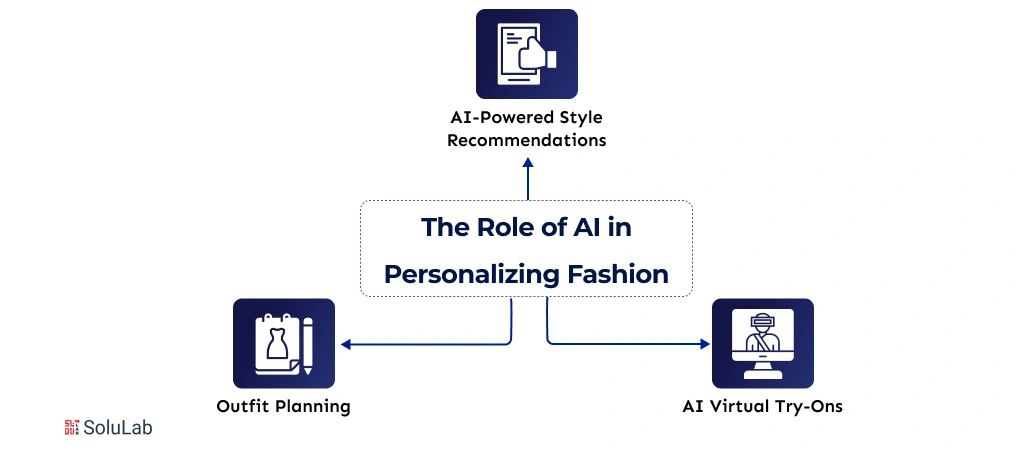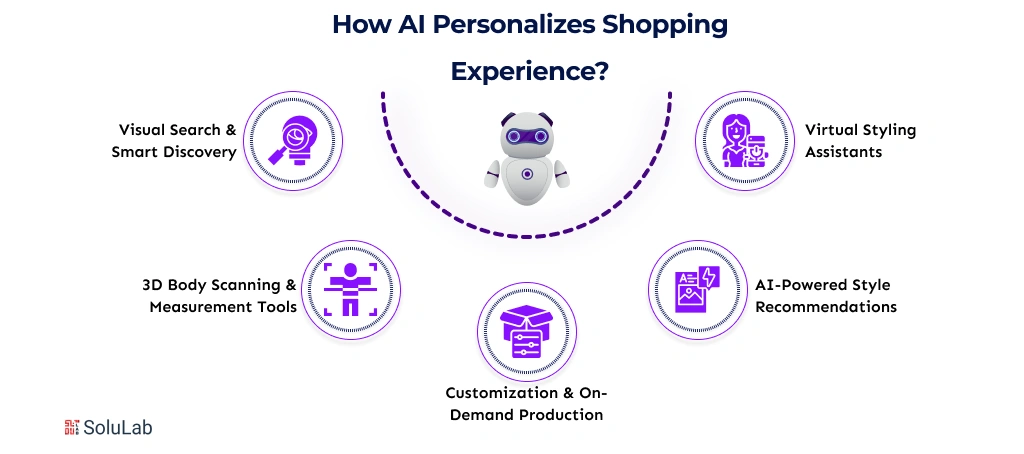
You spend hours scrolling online, searching for that perfect outfit, only to realize it doesn’t fit well or match your style. So, you start the hunt again.
But what if you could see exactly how an outfit would look on you without even trying it on? With AI, that’s now possible. It helps you find the perfect size, color, and style that truly suits you.
AI analyzes your body type, color preferences, and shopping history to create a wardrobe that’s uniquely yours. From virtual fitting rooms to personalized outfit recommendations, it ensures every piece feels tailor-made.
In this blog, we’ll explore the role of AI in personalizing fashion, its key benefits, and what the future of smart styling looks like.
The Role of AI in Personalizing Fashion
Artificial Intelligence is changing the fashion by making clothing more personal, stylish, and convenient. From personalized suggestions to virtual try-ons, AI is redefining how we shop and style ourselves.

1. AI-Powered Style Recommendations: A Personal AI stylist analyzes your fashion preferences, body type, and past purchases to suggest outfits that match your personality. This helps you discover styles you’ll value while saving time and avoiding mismatched fashion choices.
2. AI Virtual Try-Ons: With the help of an AI fashion assistant, you can now visualize how clothes will look on you without physically trying them on. Using augmented reality and body mapping improves online shopping accuracy and boosts customer satisfaction.
3. Outfit Planning: AI in the fashion business helps users plan daily outfits based on weather, occasion, and current trends. These intelligent tools recommend clothing combinations, ensuring your wardrobe stays fresh, stylish, and perfectly aligned with your personal taste.
Benefits of AI-Powered Wardrobe Personalization
The global AI in fashion market is expected to reach USD 1.6 billion by 2034 (CAGR ~12.7%).
AI-powered wardrobe personalization is improving how people shop and dress by offering smart, data-driven fashion experiences that ensure comfort, convenience, and sustainability for every individual’s style and body type.
- Perfect Fits and Fewer Returns: AI analyzes your body measurements, previous purchases, and fitting preferences to recommend the perfect size every time. This reduces the hassle of ill-fitting clothes and minimizes return rates for online shoppers.
- Saves Time and Effort: Instead of browsing through endless clothing options, AI curates personalized outfit recommendations based on your taste, occasion, and budget, saving hours of shopping time while ensuring every piece matches your unique style.
- Sustainable Fashion Decisions: By helping customers find the right fit and style the first time, AI significantly cuts down clothing waste and shipping emissions. This leads to a more sustainable and eco-friendly fashion ecosystem
How AI is Personalizing Your Shopping Experience?
Artificial Intelligence solutions provide personalized experiences from outfit recommendations to perfect fitsmaking shopping smarter, more interactive, and as per your style preferences.

1. Virtual Styling Assistants
AI stylists use smart algorithms to curate outfits based on your taste, weather, and upcoming occasions. Chat-based assistants and AI virtual try-on clothes apps let you preview looks instantly, no need for fitting rooms!
2. AI-Powered Style Recommendations
AI studies your past choices, body type, and favorite brands to deliver spot-on outfit suggestions. Platforms like Stitch Fix, Zalando, and Amazon Personal Shopper use AI-powered virtual try-on tech to refine your unique style.
3. Customization & On-Demand Production
From choosing colors to altering designs, AI allows you to co-create fashion pieces. Brands like TexSPACE Today use on-demand manufacturing to reduce waste, ensuring every piece feels made just for you.
4. 3D Body Scanning & Measurement Tools
Using computer vision, AI takes accurate body measurements and suggests the right size for every brand, minimizing returns and making sure you always get the perfect fit.
5. Visual Search & Smart Discovery
AI lets you upload an image to find similar outfits or accessories online instantly. This feature simplifies discovery and helps you explore fashion that matches your exact visual inspiration.
Real World Examples of Brands Using AI in 2025
In 2025, the most popular fashion brands are redefining personalization with AI integration into their design, styling, and fitting processes, changing the customer experience of shopping, dressing, and enjoying fashion.
1. Stitch Fix
Stitch Fix has AI algorithms that can suggest personalized outfits based on customer preferences, style history, and body type. Its data-driven strategy enables stylists to send customized clothing boxes that best suit every user in terms of taste and lifestyle.
2. Nike Fit
Nike Fit uses machine learning and computer vision to enable its customers to locate the exact size of shoes by scanning them with their smartphones. This makes it a better fit, improves product returns and customer satisfaction by combining the technology with the comfort of the customers.
3. H&M
H&M uses AI to forecast trends in fashion and to control stock. Through customer data analysis and purchase behavior, the brand makes outfit recommendations personal and enhances sustainability through better production and waste reduction.
4. Zalando
Zalando uses machine learning to provide AI-based outfit recommendations. It analyzes the behavior of shoppers, social media trends, and product reviews to propose items suitable to the individual style requirements and fashion trends.
Future of AI in Fashion Trends
AI analyzes shopping patterns, social media activity, and customer feedback to craft clothing suggestions that match individual styles. With Computer vision and AI, brands can predict preferences, personalize experiences, and deliver fashion that feels tailor-made for every shopper.
1. Sustainable fashion: AI enables designers to discover eco-friendly materials, optimize fabric use, and reduce waste in production. Through AI development solutions, fashion brands can make sustainability scalable, creating ethical designs without compromising on quality, style, or creativity.
2. Trend Forecasting: AI systems scan global fashion data from runway shows to influencer posts to anticipate upcoming trends with remarkable accuracy. This advanced Trend Forecasting helps designers and retailers stay ahead of customer demands and shape collections that truly resonate with the market.
3. Design new styles based on individual taste: With AI analyzing body types, colors, and past purchase behavior, brands can create designs that perfectly fit each consumer’s personality. This fusion of Computer vision and AI ensures style recommendations that are both data-driven and emotionally appealing.
Conclusion
Artificial Intelligence in the fashion industry is changing how we choose, style, and wear our clothes. From personalized outfit recommendations to accurate fittings and sustainable designs, AI has now become your personal style assistant. As technology continues to evolve, we can expect even smarter, more intuitive fashion tools that combine creativity with convenience.
Digital Quest, a travel business, partnered with SoluLab to develop an AI-powered chatbot using Generative AI. The chatbot enhanced customer engagement by offering real-time, personalized travel recommendations and hassle-free reservations. It also integrated user feedback and multi-language support, resulting in improved user experience and high ROI.
SoluLab, an AI development company can help you build smart styling tools, virtual fitting solutions that your customers will love. Contact us today to discuss further!
FAQs
1. How is computer vision used in the fashion industry?
Computer vision in the fashion industry allows systems to identify colors, patterns, and fabrics, enabling virtual try-ons, size detection, and visual search for similar clothing styles online.
2. Is AI helping make fashion more sustainable?
Absolutely. AI helps brands optimize production, reduce waste, and use eco-friendly materials by predicting demand and avoiding overproduction.
3. What are some common AI use cases in fashion?
Popular AI in fashion use cases include personalized styling, virtual try-ons, visual search, predictive analytics for trends, and sustainable material design.
4. What technologies power AI-driven fashion?
Technologies like machine learning, computer vision in the fashion industry, and natural language processing work together to personalize AI wardrobes and enhance shopping experiences.
5. Can AI help online shoppers choose the right size?
Yes, AI uses virtual fitting algorithms and body scanning data to recommend accurate sizes, minimizing fitting errors in online purchases.





